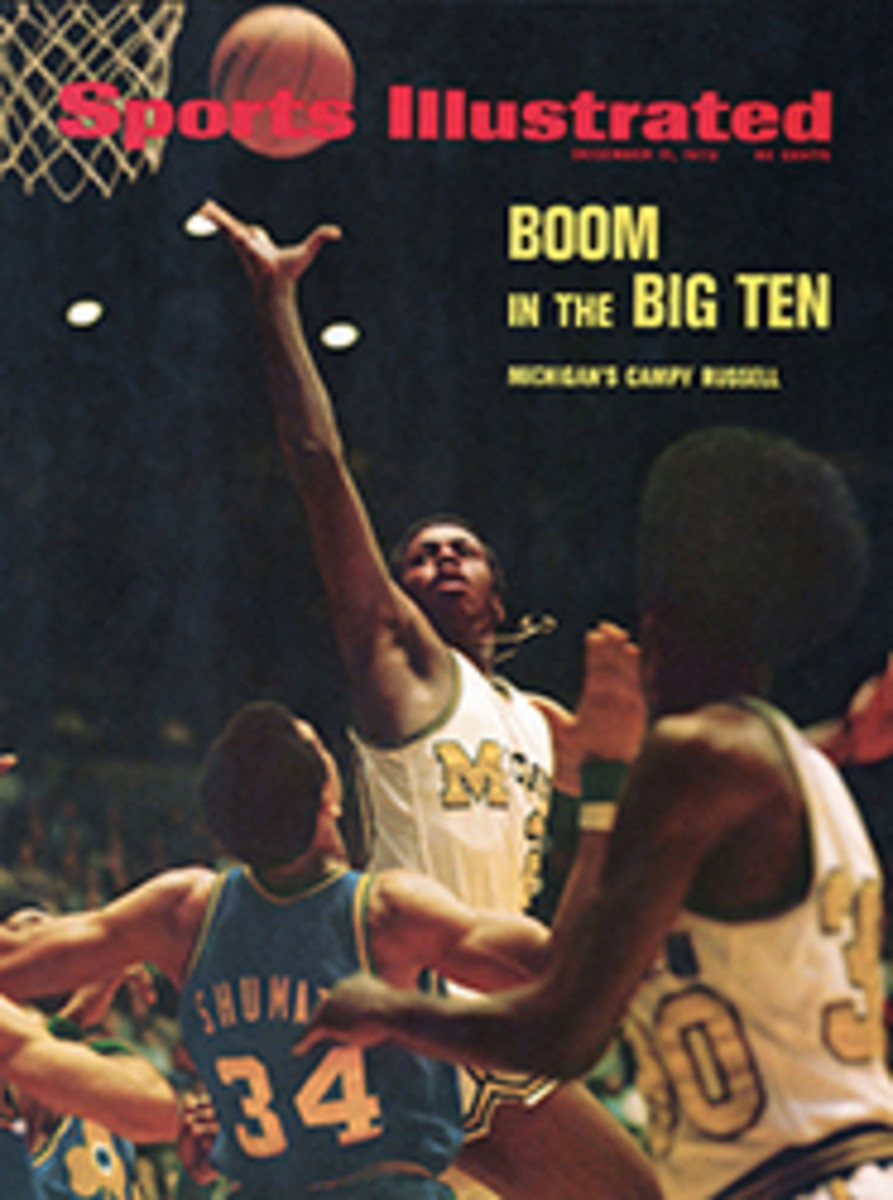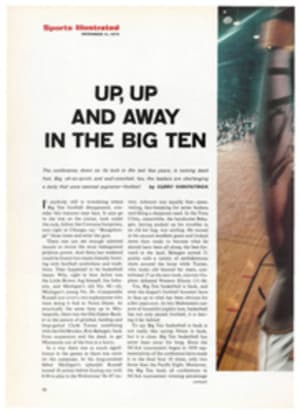
Chuck Ealey: champion and still winner
In 1909 Earl Grey, the Governor General of Canada, not wanting to be outdone by a predecessor named Stanley, contributed a cup for the amateur rugby football championship of Canada. It was a motley, $48 affair of soft metals coated in silver plate; when Earl Grey died in 1917 the official tribute stated: "Perhaps he will best be remembered as founder of the Earl Grey musical and dramatic competitions."
Whatever happened to Earl Grey's cultural contributions, last week his Grey Cup served once more as annual justification for a seven-day Canadian blowout that threatened to raise the roof off trim little Hamilton (pop. 300,000). Ever since Calgary fans arrived in Toronto in 1948 in a 17-car train full of chuck wagons and flapjacks, cowboys and cowgirls, and started an impromptu parade, the Grey Cup has been revered as a bastion of national unity. Packed into one frantic week in Hamilton, were the Grey Cup parade, the largest annual parade in Canada; the Miss Grey Cup contest, with Bonanza's Lorne Greene doing the Bert Parks bit; and the Grey Cup dinner, open to an intimate closed-circuit-TV crowd that filled two hotel ballrooms. Canada's most revered football awards were given out there last Thursday in true Oscar fashion—the two finalists in each category in black tie, arty film strips of their exploits, and the drum roll, the sealed envelope. The week was referred to in the papers as the "Grand National Drunk" and police made it perfectly clear that as long as you did not go around yelling "Fire!" in crowded bars, you could do as you pleased. And people did. One enterprising politician campaigned by passing out complimentary Alka-Seltzer. And, oh yes, at the end of the hangover the Hamilton Tiger-Cats and the Saskatchewan Roughriders of the Canadian Football League played a championship game for Earl Grey's cheesy trophy.
Grey Cup sites are picked two years in advance and the coincidental presence of a home team this season only compounded the madness. Hamilton is roughly comparable to Pittsburgh or Green Bay, depending on whether you are discussing its steel industry or its obsession with football. The mayor is a former sportscaster, and more than 15,000 people jammed King Street for an old-fashioned collegiate pep rally the night before the final eastern playoff game two weeks ago. The city is just as proud of its blue-collar image. Its trademark is a lunch pail and its float in Saturday's parade was pulled by a tractor disguised as a yellow hard hat. The town won the bidding for the 1972 Grey Cup because the CFL's Hall of Fame was opening there and because recently renovated Ivor Wynne Stadium had the nation's largest capacity (34,000) and one of its three artificial fields. Besides, for the Dominion, Hamilton is a warm-weather site, approximating the balmy temperatures in nearby Buffalo. In comparison, Regina, the home of the Roughriders, is 500 miles farther north.
The Tiger-Cats are no strangers to these classics. Notorious for overwhelming defenses based around mammoth tackles, they had appeared in 10 Grey Cups and won five between 1953 and 1967. But since 1968, although they always made the playoffs, they failed to survive them. Hamilton continued, however, to assemble the most intriguing cast of characters to be found on any team on either side of the border.
The senior personality is 6'4", 285-pound Angelo Mosca, a friendly Notre Dame alumnus who has been the bad boy of the league ever since, as he puts it, he "baffed out" a British Columbia player in Vancouver in the 1963 cup game, DIRTIEST PLAYER INJURES STAR, a local newspaper headlined it. Mosca discusses the incident now with a sheepish smile. "It bothered me until I learned I could capitalize on it," he says. "Now I'm a household word in Canada." So he plans to retire from football this year and go into wrestling fulltime, where, he explains, "I can make $50,000 at the drop of a hat."
While Mosca helped maintain the tradition of a strong Hamilton defense, the offense sagged badly in the last few seasons. To remedy the situation this year, Hamilton hired a new coach, Jerry Williams of the late Philadelphia Eagles—er, rather, late of the Philadelphia Eagles—and suddenly the Tiger-Cats became aggressors again. They led the league in scoring behind an all-conference rookie black quarterback, who threw to, among others, a grandfather and the oldest player in the CFL—and these pensioners are not one and the same.
The grandfather is Tommy-Joe Coffey, an alumnus of West Texas State, who, in August, surpassed Raymond Berry's world-record total reception mark and the 10,000-yard receiving barrier on the same play. "And 13 years ago they told me I was too slow," he says. Grandfather Coffey is, however, almost a year junior to his receiving cohort, a balding, bespectacled, puny 36-year-old college educator named Garney Henley.
A lecturer in physical education at nearby Guelph University, Henley has been a perennial all-star safety ever since leaving little Huron (S. Dak.) College in 1960, but this year, because of his speed—at 36, mind you, his speed—Williams moved him to wide receiver to jazz up the offense. It was a perceptive shift, and Henley was named the league's Most Outstanding Player.
Yet youth will be served—and not only lots of liquor during Grey Cup week. The catalyst for Hamilton's success was the rookie, Chuck Ealey, from the University of Toledo. "He's the great equalizer," Montreal General Manager J. I. Albrecht said last week. "He's the difference between winning and losing."
Ealey went to Canada after he was not included among the 442 players selected in last February's NFL draft. Many have suggested that an NFL prejudice against black quarterbacks was the determining factor in his rejection by all 26 teams. George Taliaferro, an assistant to the president of Indiana University, who created no controversy when he was an NFL black quarterback two decades ago (briefly, with the Colts), said point-blank two years ago: "This country is not at a point where it will accept a black quarterback leading its finest white boys."
Ealey himself, simply and directly, says: "I suppose that could be a possible reason I wasn't drafted, but I'd hate to think that it was."
NFL team officials provide a variety of explanations now. There were rumors at the time that Ealey had received sizable offers from Canada and, because the scouts had certified Ealey as too short and/or possessing a weak, scatter arm, he could not possibly be more than a 10th-round choice. Thus, as the excuses go, he was not worth bidding for against a Canadian team.
But too small? Ealey measures out at 6', 195, which puts him in a class with Sonny Jurgensen, Fran Tarkenton and Johnny Unitas. A poor arm? In college he passed more accurately than Joe Namath, Mike Phipps, Archie Manning or Terry Bradshaw did—and Ealey had a longer average gain per completion than Namath, Manning or John Reaves, the alltime college total passing yardage leader who was drafted in the first round last year.
Well, say the scouts, statistics do not mean a thing; it is intangibles that count. For a quarterback, that means winning, the standard that made Unitas and Otto Graham legendary and Jurgensen and Tarkenton questionable commodities. Yet here Charles Ealey Jr. is without peer. In three years of high school play, his team was 30-0; in three years at Toledo, the Rockets were 35-0.
At Hamilton, Ealey did not start until the third game, and then he actually lost two straight games, which dropped the Tiger-Cats to 1-3, 2½ games out of first. Then Ealey started the familiar business of winning all over again. He led Hamilton to 10 straight victories and a first-place finish in the Eastern Conference. In a two-game, total-point playoff series with Ottawa, he brought the Tiger-Cats from a 19-7 deficit to a 27-27 tie at the end of seven quarters. Then Hamilton's teen-age placekicker, Ian Sunter, booted home a field goal to put the Tiger-Cats in the Grey Cup and perpetuate the Ealey phenomenon.
As at Toledo, he is known as Mr. Cool. "I've never seen a rookie show so much poise, so much discipline, so much unassuming confidence in himself," says Coffey. "I can't see how the NFL let him get away, but I'm sure glad they did."
"He'd make it in the NFL. I have no doubts," says Williams. "The scouts might have concluded that he could only be a roll-out type because that's all they saw him do at Toledo. When he first came up here he left the pocket too early, but it wasn't long before he was sitting in there and picking out the right receiver. Still, we have some pass patterns predicated on seven seconds that call for him to move around. They're primarily effective against the zone, which Saskatchewan plays most of the time."
As soon as the game started—following a ceremonial kickoff by the current Governor General, with the sixth Earl Grey holding—Ealey threatened to make it no contest for Hamilton. He passed 16 yards to Running Back Dave Fleming to conclude a 52-yard drive, and then moments later the 19-year-old Sunter, a Scottish immigrant, kicked a 27-yard field goal to make it 10-0.
But Saskatchewan fought back behind Ron Lancaster, who has led the team since 1963, completing more passes for more yards and more touchdowns than any other quarterback in CFL history. Mixing short passes with runs by George Reed, Canada's alltime leading ground-gainer from Washington State, Lancaster got the Roughriders a 10-10 tie by half-time—and it was still that way with just under two minutes left in the game when the Tiger-Cats took over the ball again on their own 15. There are no timeouts in Canadian football, only three downs, and the field is 110 yards long, so overtime seemed a certainty. And then Chuck Ealey started to work his winning magic.
For the first time in the game, he crossed up the Roughriders and went to Tight End Tony Gabriel for three straight first downs into Saskatchewan territory. A two-yard pickup then made it second and eight with less than 40 seconds remaining, and this time Ealey found Henley, who made a great sliding catch for the first down at the Rough-rider 26. One ball-control play later, as the clock ran out, the callow Sunter casually pounded home the winning field goal: 13-10, Hamilton.
Half an hour later, Ealey stood by his locker, dripping in champagne, Earl Grey's trophy on the bench next to him. To go with his rookie-of-the-year award, he had also earned a new car as the Grey Cup's most valuable player. And he could not keep a slight smile from flickering across his face. "I wonder what the NFL is thinking now?" the winner asked.
PHOTO
EALEY, THE ROOKIE, LAUGHS WITH TOMMY-JOE COFFEY, HIS GRANDFATHER RECEIVER

